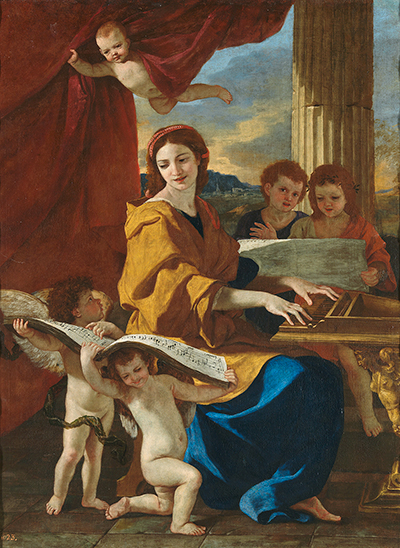Painted by Nicolas Poussin around 1627, Saint Cecilia is found within the Prado Museum in Madrid. Saint Cecilia, or Cecelia, is known in the Catholic Church as the patron saint of music.
A virgin and martyr, she is believed to have lived during the second or third century. According to tradition, she did not allow the sounds of musical instruments to distract her from her devotion to God. Her relics are found in a fifth century church in the Trastevere neighbourhood of Rome. The elegant oil on canvas painting shows Saint Cecilia playing a harpsichord or a similar type of keyboard instrument. The musical instrument that she plays sits on a pedestal that resembles a golden sculpture. She is dressed in a blue tunic as well as ocher robes.
The artwork also features two cherubs holding a scroll with a musical score, which Saint Cecilia is reading. Two angels sing in the background using another score, while a third cherub soars above lifting a curtain supported by a column. Featuring refined colours and sophisticated execution, Saint Cecilia was created during Poussin's first residence in the Italian capital. This period lasted from 1624 until 1640. The artist’s works from the late 1620s and early 1630s often represented a bright palette and warm colours, which are illustrated in Saint Cecilia. This is particularly true with the main figure's bright and vibrant garments. Originally the piece was attributed to Charles Mellin, and the confusion was likely caused by the art being created in collaboration with assistants in Poussin's studio.
Clues from other paintings leave little doubt the work is by Poussin. The face of Saint Cecilia, for example, appears in other works by Poussin such as The Holy Family with Saint John and Saint Elizabeth found in Moscow's Puskin Museum. The face is again found in the Mystical Marriage of Saint Catherine, which is housed in the National Gallery in Edinburgh. While the painting is now found in the Prado Museum, little is known about the painting’s history before it was mentioned in 1734 as part of an inventory of the Alcazar Palace in Madrid. It may have been purchased by King Philip V of Spain, who acquired several of Poussin's works.




